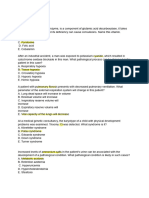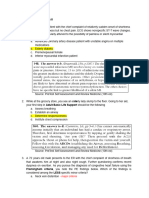0 ratings0% found this document useful (0 votes)
152 viewsChapter 14 Case Studies - Jenny
Chapter 14 Case Studies - Jenny
Uploaded by
Bhawna JoshiThis 48-year-old woman presented with an unexplained anemia, fever, enlargement of the liver and spleen, lymph nodes in the axillary and inguinal areas, and a collection of fluid in the abdomen (ascites). Her anemia did not respond to iron therapy and she was ultimately diagnosed with lymphoma at autopsy.
Copyright:
© All Rights Reserved
Available Formats
Download as DOCX, PDF, TXT or read online from Scribd
Chapter 14 Case Studies - Jenny
Chapter 14 Case Studies - Jenny
Uploaded by
Bhawna Joshi0 ratings0% found this document useful (0 votes)
152 views2 pagesThis 48-year-old woman presented with an unexplained anemia, fever, enlargement of the liver and spleen, lymph nodes in the axillary and inguinal areas, and a collection of fluid in the abdomen (ascites). Her anemia did not respond to iron therapy and she was ultimately diagnosed with lymphoma at autopsy.
Original Title
Chapter 14 Case Studies_Jenny
Copyright
© © All Rights Reserved
Available Formats
DOCX, PDF, TXT or read online from Scribd
Share this document
Did you find this document useful?
Is this content inappropriate?
This 48-year-old woman presented with an unexplained anemia, fever, enlargement of the liver and spleen, lymph nodes in the axillary and inguinal areas, and a collection of fluid in the abdomen (ascites). Her anemia did not respond to iron therapy and she was ultimately diagnosed with lymphoma at autopsy.
Copyright:
© All Rights Reserved
Available Formats
Download as DOCX, PDF, TXT or read online from Scribd
Download as docx, pdf, or txt
0 ratings0% found this document useful (0 votes)
152 views2 pagesChapter 14 Case Studies - Jenny
Chapter 14 Case Studies - Jenny
Uploaded by
Bhawna JoshiThis 48-year-old woman presented with an unexplained anemia, fever, enlargement of the liver and spleen, lymph nodes in the axillary and inguinal areas, and a collection of fluid in the abdomen (ascites). Her anemia did not respond to iron therapy and she was ultimately diagnosed with lymphoma at autopsy.
Copyright:
© All Rights Reserved
Available Formats
Download as DOCX, PDF, TXT or read online from Scribd
Download as docx, pdf, or txt
You are on page 1of 2
Chapter 14 Case Studies
Case Report
This 48-year-old woman had an unexplained anemia with low-grade fever 4 years before her death. Six
months before, bronchopneumonia developed, followed by return of severe anemia and continued pyrexia
(fever). She was febrile (feverish), appeared pale, and had slight hepatomegaly and splenomegaly. Lymph
nodes were palpated in the axillary and inguinal areas, and ascites developed. The chronic anemia did not
respond to iron therapy. There was no evidence of blood loss or hemolysis. Diagnosis of lymphoma was
confirmed by autopsy.
1. What two organs were enlarged in the patient? ........................................
A. Liver and lungs
B. Lungs and spleen
C. Liver and spleen
D. Spleen and bone marrow
2. Where were lymph nodes felt? .............
A. Groin and armpit
B. Armpit and chest
C. Groin and abdomen
D. Abdomen and armpit
3. What is ascites? ..........................................................
A. Blockage of the intestine
B. Edema in the extremities
C. Collection of fluid in the chest
D. Collection of fluid in the abdomen
4. What was the probable cause of the patient’s anemia? ................................
A. Chronic blood loss
B. Destruction of blood
C. Malignant tumor of lymph nodes
D. Iron deficiency
Symptoms of Hodgkin Disease
The most common initial feature of Hodgkin disease is painless, asymmetrical enlargement of cervical
lymph nodes. Symptoms may also originate from compression of neighboring structures by growing
tumor masses. For example, cough, dyspnea, dysphagia, and upper extremity edema may result from a
mediastinal mass impinging on the tracheobronchial tree, esophagus, or superior vena cava. Edema of
lower extremities and urinary or gastrointestinal disturbances may result from retroperitoneal lymphatic
involvement. Splenomegaly is present in about half the cases.
1. How do most patients present with Hodgkin disease? ................................
A. Lymph nodes enlarged under the arm
B. Enlargement of the spleen
C. Compression of the trachea
D. Lymphadenopathy in the neck
2. How could upper extremity edema occur? ................................................
A. Tumor pressing on the esophagus
B. Tumor blocking the main vein bringing blood to the heart
C. Because of dysphagia
D. Because of dyspnea
3. What could cause bladder problems? ..........................................
A. Tumor behind the abdomen
B. Tumor pressing on the bronchial tubes
C. Enlargement of the spleen
D. Upper extremity edema
You might also like
- Advanced Medical Life Support: AMLS PretestDocument14 pagesAdvanced Medical Life Support: AMLS Pretestsattom67% (3)
- Sample of Exam Questions-1Document9 pagesSample of Exam Questions-1api-3700599100% (2)
- Sample Test Questions: Krok 2Document41 pagesSample Test Questions: Krok 2kjkNo ratings yet
- Medicine p4Document16 pagesMedicine p4Noor SeckamNo ratings yet
- Sample Test Questions: Krok 2Document29 pagesSample Test Questions: Krok 2Hisham aliNo ratings yet
- Sample Test Questions: Krok 2Document29 pagesSample Test Questions: Krok 2Daniel AshooriNo ratings yet
- InternalDocument20 pagesInternalEmil AbdullayevNo ratings yet
- New Pool iMM PDFDocument24 pagesNew Pool iMM PDFFisher manNo ratings yet
- Blood Vessels QuizDocument28 pagesBlood Vessels Quiztatti999No ratings yet
- MCQs and Cases in MedicineDocument14 pagesMCQs and Cases in Medicineyoune6No ratings yet
- Kiểm Tra 60p - Đề 4Document3 pagesKiểm Tra 60p - Đề 4quynhnguyen.31231024063No ratings yet
- XXDocument44 pagesXXJoydeb MondalNo ratings yet
- MCQ (Medicine, Surgery, Clinical Skills)Document14 pagesMCQ (Medicine, Surgery, Clinical Skills)samali253samNo ratings yet
- MCQsDocument21 pagesMCQsZweNo ratings yet
- Krok2 - Medicine - 2016Document25 pagesKrok2 - Medicine - 2016ashighaNo ratings yet
- 2023 MayDocument36 pages2023 MayReshma Shaji PnsNo ratings yet
- Share FileDocument16 pagesShare FilerbnsncairoNo ratings yet
- Swammy Plab 1 MockDocument32 pagesSwammy Plab 1 Mockfreelancer08No ratings yet
- Krok 2 2012-2019Document59 pagesKrok 2 2012-2019Donya GholamiNo ratings yet
- Internal Propedeutics MCQ - SDocument39 pagesInternal Propedeutics MCQ - Sps886rd6chNo ratings yet
- Krok 2024Document7 pagesKrok 2024hdidoumeryam09No ratings yet
- Lung Cancer CaseDocument13 pagesLung Cancer CaseAbdirahman Ali YabarNo ratings yet
- Medicine - 1 Solved BCQS Final Year MBBS LumhsDocument20 pagesMedicine - 1 Solved BCQS Final Year MBBS LumhsShairy SohoNo ratings yet
- PLAB 1 MockDocument34 pagesPLAB 1 MockJOSEPH NDERITUNo ratings yet
- Krok 2 - 2014 (Therapy)Document74 pagesKrok 2 - 2014 (Therapy)areenNo ratings yet
- LUMHS MEdICINE 1 Corrected File - RAJA ALTAFDocument20 pagesLUMHS MEdICINE 1 Corrected File - RAJA ALTAFShairy SohoNo ratings yet
- Internal Medicine Must To KnowDocument110 pagesInternal Medicine Must To Knowomaryshaban038No ratings yet
- Chapter 24: Alterations of Cardiovascular Function Power-Kean Et Al: Huether and Mccance'S Understanding Pathophysiology, Second Canadian EditionDocument20 pagesChapter 24: Alterations of Cardiovascular Function Power-Kean Et Al: Huether and Mccance'S Understanding Pathophysiology, Second Canadian EditionmonicaNo ratings yet
- De Avcn 2Document5 pagesDe Avcn 2pahmtanhNo ratings yet
- Partial of PathophysiologyDocument56 pagesPartial of Pathophysiologytoolsdesk1No ratings yet
- MCCD 2022Document25 pagesMCCD 2022ANN MARIA JOYNo ratings yet
- Medicine P2 2Document16 pagesMedicine P2 2Noor SeckamNo ratings yet
- 5th Year 112 PediatricsDocument12 pages5th Year 112 PediatricsAmjad A. Amir100% (2)
- USMLE STEP 1 Review - StudentDocument81 pagesUSMLE STEP 1 Review - StudentKawther AbdallahNo ratings yet
- IM Feedback - ALLDocument42 pagesIM Feedback - ALLEricNo ratings yet
- Pathology McqsDocument40 pagesPathology Mcqspkpowerhouse100% (1)
- HemodynamicsDocument3 pagesHemodynamicsSadia Abbasi100% (1)
- Group B 2K20, M2Document14 pagesGroup B 2K20, M2DebsNo ratings yet
- MCQ InternalDocument21 pagesMCQ InternalKowsalya SelvarajNo ratings yet
- Prekrok 2 Online Exam DR Ashiq TutorialDocument23 pagesPrekrok 2 Online Exam DR Ashiq TutorialPreetha100% (1)
- DR Ashiq Tutorials Pre-Krok 1222Document66 pagesDR Ashiq Tutorials Pre-Krok 1222Praveen KpNo ratings yet
- NEPHRO Allergo ExamDocument5 pagesNEPHRO Allergo ExamAllison Eunice ServandoNo ratings yet
- Medicine COC Exam Questions and Answers PDF: Main NavigationDocument45 pagesMedicine COC Exam Questions and Answers PDF: Main NavigationTadesse Muhammed50% (2)
- SP Pathology MCQDocument17 pagesSP Pathology MCQMuhammad Bilal80% (5)
- Special Pathophysiology Quiz 1: Digestive System DisordersDocument8 pagesSpecial Pathophysiology Quiz 1: Digestive System DisordersBea DizonNo ratings yet
- Krok 1 - 2014 (Path-Physiology)Document31 pagesKrok 1 - 2014 (Path-Physiology)Rashmi SuryavanshiNo ratings yet
- All Year 2005 To 2023Document625 pagesAll Year 2005 To 2023xrnmtyz7fnNo ratings yet
- Fcps Past Papers PartDocument25 pagesFcps Past Papers PartBeena Muhammad Fahad100% (1)
- Ultimate Recalls IMDocument40 pagesUltimate Recalls IMPavan chowdaryNo ratings yet
- Pancytopenia Secondary To Bacterial SepsisDocument16 pagesPancytopenia Secondary To Bacterial Sepsisiamralph89No ratings yet
- Medicine A Supply 2022: Course of Oral Steroids. On Examination There Is Point Tenderness On Upper Lumber SpineDocument8 pagesMedicine A Supply 2022: Course of Oral Steroids. On Examination There Is Point Tenderness On Upper Lumber SpineRabia RabiaNo ratings yet
- McCance Patho Review QsDocument17 pagesMcCance Patho Review Qsiamdara100% (1)
- November 2024, 28th October First Trial Exam Medicine AnsweredDocument24 pagesNovember 2024, 28th October First Trial Exam Medicine AnsweredAhmed AmerNo ratings yet
- #EMLE November 2024 ExamsDocument104 pages#EMLE November 2024 Examscahev70533No ratings yet
- PATHOLOGYDocument10 pagesPATHOLOGYDivine SangutanNo ratings yet
- HistologyDocument13 pagesHistologyJack frimpongNo ratings yet
- CMT 05210 Internal MedicineDocument23 pagesCMT 05210 Internal MedicineBashiru SelemaniNo ratings yet
- Pleural Effusion, A Simple Guide To The Condition, Treatment And Related ConditionsFrom EverandPleural Effusion, A Simple Guide To The Condition, Treatment And Related ConditionsNo ratings yet
- Angina Unveiled: Navigating the Depths of Cardiovascular ComplexityFrom EverandAngina Unveiled: Navigating the Depths of Cardiovascular ComplexityNo ratings yet
- Cvspa03 ThromboembolismDocument7 pagesCvspa03 ThromboembolismRobert So JrNo ratings yet
- Ly 2012Document8 pagesLy 2012bert.sutterNo ratings yet
- The Popliteal ArteryDocument11 pagesThe Popliteal ArteryKrishnamurthy VenkatachalamNo ratings yet
- aLL MCQS AMALI WEEKLYDocument58 pagesaLL MCQS AMALI WEEKLYWajiha ZahraNo ratings yet
- SH Catalogue - Ophthalmic & MicroDocument8 pagesSH Catalogue - Ophthalmic & MicroSaqibullah ShahzadNo ratings yet
- Bariatric Surgery OxfordDocument7 pagesBariatric Surgery OxfordJose Tomás MooreNo ratings yet
- Case Pres - Imperforate AnusDocument26 pagesCase Pres - Imperforate AnusMerlash MerlaNo ratings yet
- Nutrition - Management of Enteral Feeding - Guidelines and Procedures ECT2353 - Updated Version PDFDocument175 pagesNutrition - Management of Enteral Feeding - Guidelines and Procedures ECT2353 - Updated Version PDFHerryAsu-songkoNo ratings yet
- Culdocentesis: G. Richard Braen and David Lee PierceDocument6 pagesCuldocentesis: G. Richard Braen and David Lee PierceebolynsurivNo ratings yet
- Activity 5 Venipuncture Procedures: Judy Ann Nichole A. Dionio, RMTDocument66 pagesActivity 5 Venipuncture Procedures: Judy Ann Nichole A. Dionio, RMTAngelica Camille B. AbaoNo ratings yet
- Medical Terminology STUDY GUIDE J23Document99 pagesMedical Terminology STUDY GUIDE J23Waikiki FisherNo ratings yet
- Pit Picking Quick TutorialDocument5 pagesPit Picking Quick TutorialkapsicumadNo ratings yet
- CBCT - DR JoachimDocument9 pagesCBCT - DR JoachimMihaela TuculinaNo ratings yet
- Lacunar InfarctsDocument14 pagesLacunar InfarctsIRENA GENINo ratings yet
- The Clinical Significance of The Retromolar Canal and Foramen in DentistryDocument24 pagesThe Clinical Significance of The Retromolar Canal and Foramen in Dentistryمحمد عبدالرحمنNo ratings yet
- Cho 2008Document15 pagesCho 2008Guilherme de FreitasNo ratings yet
- Enhanced Recovery After Surgery at CesareanDocument1 pageEnhanced Recovery After Surgery at Cesareanpiceng ismailNo ratings yet
- Common Abbreviations 1Document4 pagesCommon Abbreviations 1NUR FATEHA NATASYA BINTI MOHAMAD HANAFI / UPMNo ratings yet
- Ultrasound For Lower Extremity Deep ThrombosisDocument12 pagesUltrasound For Lower Extremity Deep ThrombosisDiego RodriguesNo ratings yet
- Mucogingival SurgeryDocument53 pagesMucogingival SurgeryAbhijeet Shete100% (3)
- Tonometer EditedDocument107 pagesTonometer EditedANUSAYA SAHUNo ratings yet
- Thoracic CageDocument74 pagesThoracic Cagesharathb771No ratings yet
- MCQ Part 1 (First Term)Document15 pagesMCQ Part 1 (First Term)Mahmoud RagabNo ratings yet
- Mechanical Ventilation, Past, Present, and FutureDocument18 pagesMechanical Ventilation, Past, Present, and FutureErving Xavier Gutiérrez VillalobosNo ratings yet
- Reconstructive LadderDocument5 pagesReconstructive LadderMary Christina ElsaNo ratings yet
- Chapter 1Document2 pagesChapter 1longaitiNo ratings yet
- OrthopedicDocument17 pagesOrthopedicTadele B EltiroNo ratings yet
- Wa0022.Document6 pagesWa0022.Ramkumar GNo ratings yet
- DVT Case StudyDocument3 pagesDVT Case StudyCrystal B Costa78No ratings yet
- Perry2008 2Document12 pagesPerry2008 2luis castroNo ratings yet

























































































